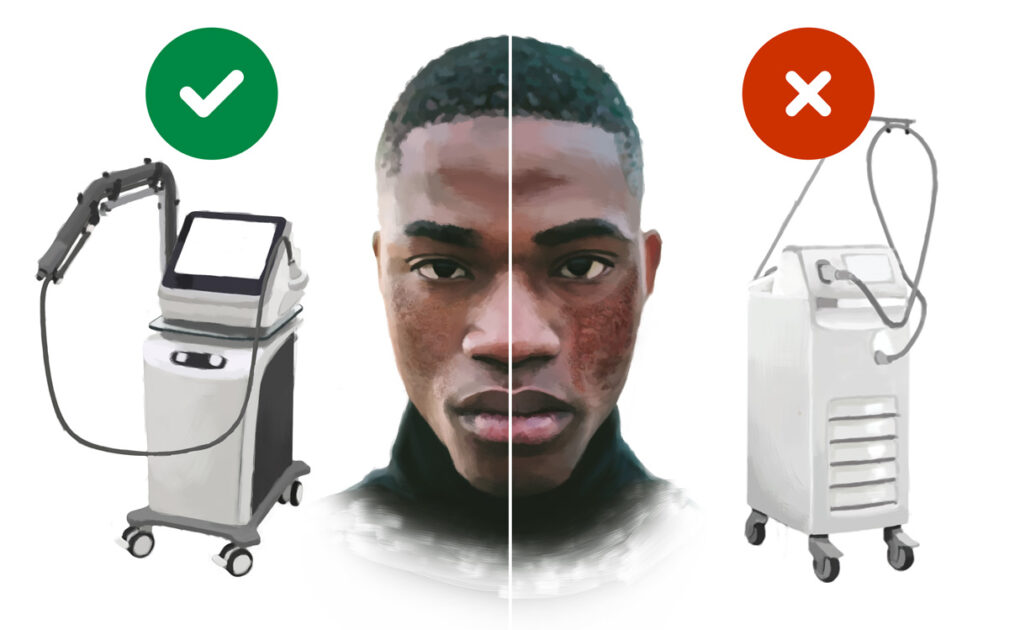The 1550 nm Erbium Laser May Be the Least Likely to Cause Hyperpigmentation, While the 1450 nm Diode Laser May Be the Most Likely to Do So

The Essential Info
Laser therapy is the gold standard for improving the appearance of indented (atrophic) acne scars, but it can come with various side effects. One potential side effect is the development of dark marks on the skin (hyperpigmentation) from the lasers, which is especially likely to occur in darker-skinned (non-Caucasian) people.
Medical providers offer a variety of different lasers for scar repair. Based on the studies performed to date, we have come up with a ranking of the lasers, from best (least likely to cause hyperpigmentation) to worst (most likely to cause hyperpigmentation):
- [Best] 1550 nm erbium laser
- 2940 nm Er:YAG laser
- 10,600 nm CO2 laser
- [Worst] 1450 nm diode laser
Additionally, the 585 nm PDL laser looks promising based on one study, but more research is necessary to confirm that this laser is unlikely to cause hyperpigmentation.
When undergoing any type of laser treatment, you can reduce your chances of hyperpigmentation by:
- Males and females: Limiting sun exposure and wearing sunscreen for at least two weeks before and after your laser treatment
- Females: Avoiding scheduling your laser appointment close to or during your period

The Science
- Lasers for Acne Scar Repair Ranked from Best to Worst for Darker-skinned (Non-Caucasian) People
- The Evidence
- 2 Things You Can Do to Lessen Your Chances of Developing Hyperpigmentation from Laser Scar Repair
- The Bottom Line
Laser therapy is relatively effective for improving the appearance of indented (atrophic) acne scars–the scars that look sunken-in. However, one potential concern, especially for darker-skinned (non-Caucasian) acne sufferers, is the risk that the laser may cause dark spots (hyperpigmentation) to temporarily appear on the skin.
There are many different lasers available for acne scar repair. If you have darker skin, you can minimize the chances of developing hyperpigmentation by choosing a laser with a good track record of treating patients like you without causing hyperpigmentation.
Darker-skinned (non-Caucasian) patients are more likely to develop hyperpigmentation from laser scar treatment
Lasers for Acne Scar Repair Ranked from Best to Worst for Darker-skinned (Non-Caucasian) People
To know which lasers are least likely to cause hyperpigmentation in darker-skinned (non-Caucasian) people, we have to look at studies that have tested lasers on people with acne scars. These studies can tell us how many darker-skinned patients ended up with dark spots from the laser treatment. Based on these findings, we have ranked the laser types from best to worst for dark-skinned patients:1-9
- [Best] 1550 nm erbium laser: Five studies that included dark-skinned patients found that this laser caused hyperpigmentation in only 1.5% of patients
- 2940 nm Er:YAG laser: Two studies that included only dark-skinned patients found that this laser caused hyperpigmentation in 27.4% of patients
- 10,600 nm CO2 laser: Three studies that included dark-skinned patients found that this laser caused hyperpigmentation in 33% of patients
- [Worst] 1450 nm diode laser: One study that included dark-skinned patients found that this laser caused hyperpigmentation in 66.7% of patients
- [Unrated] 585 nm PDL laser: One study that included dark-skinned patients found that this laser caused hyperpigmentation in 0% of patients, so it looks promising, but more research is necessary to confirm this finding
- [Unrated] 1927 nm thulium laser, 1540 nm diode laser, and 1440 nm Nd:YAG laser: No study so far has tested these lasers on dark-skinned (non-Caucasian) patients, so we cannot determine how likely they are to cause hyperpigmentation in this group
If you would like to know more about how these laser types work and exactly what the laser names mean, feel free to expand the section below.
Types of Lasers for Acne Scar Repair: The Full Scoop
All the lasers for treating acne scars fall into two major classes:
- Ablative (skin-removing) lasers: “Ablative” means “removing,” and these lasers literally remove skin. They work by rapidly heating up water molecules in the epidermis (the upper layer of the skin) to “vaporize” this skin layer. Because ablative lasers completely strip the epidermis and trigger it to regrow, they can achieve dramatic results, but they also come with a long recovery time and a relatively high risk of side effects like hyperpigmentation.
- Non-ablative (non-skin-removing) lasers: These lasers work by causing a controlled injury in the deep layer of the skin called the dermis. This triggers skin remodeling and the formation of new collagen, the protein that makes our skin supple. As the skin slowly reshapes itself from the inside, results appear gradually and tend to be more modest compared to those from ablative laser treatment. However, non-ablative lasers offer the advantages of a short recovery time and a relatively low risk of side effects.10
Both ablative and non-ablative lasers can come in either of two forms:
- Non-fractional lasers: These older lasers treat the entire skin surface in a given area without leaving any gaps. Since an entire section of skin is damaged, healing takes longer than with fractional lasers.
- Fractional lasers: These newer lasers emit many small pinpoints of laser light in a grid-like pattern, leaving the skin in-between the pinpoints untouched. Since only a small portion of the skin is damaged, healing time is shorter compared to non-fractional lasers.10,11
The table below provides examples of each group of lasers.
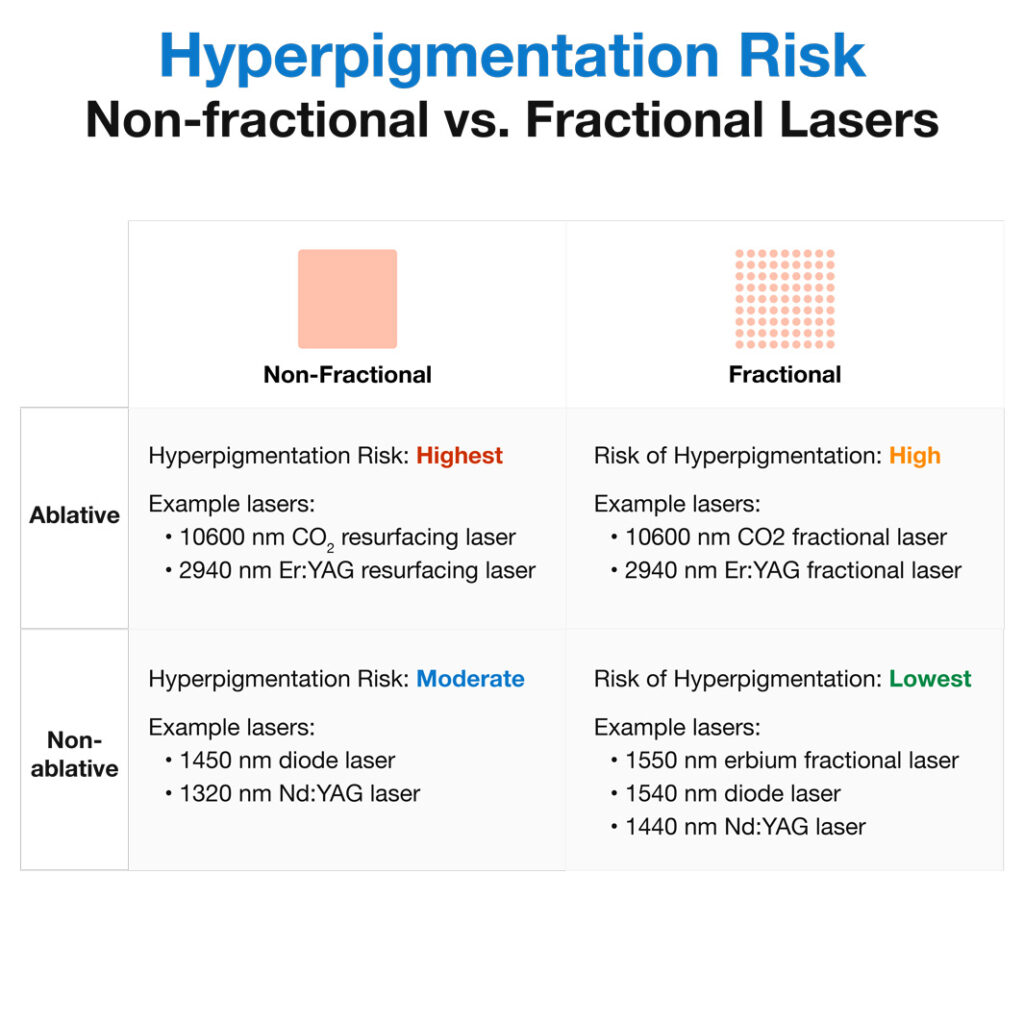
For some lasers, like the 10,600 nm CO2 laser, you have a choice between non-fractional and fractional versions. While both of these come with a relatively high risk of hyperpigmentation, the risk does tend to be lower with the fractional laser.1,6,9
Now let’s unpack those complicated laser names. Each laser name typically contains two parts:
- Wavelength: The first part of a laser’s name is a number between 500 and 11,000 that tells us the wavelength of light the laser emits, in nanometers (nm). Wavelengths between 500 and 760 nm denote different colors of visible light. This means that we can see colored light emerging from these types of lasers. Wavelengths above 760 nm correspond to infrared light, which we cannot see but which we perceive as heat.
- Material: The second part of a laser’s name is either a word or an acronym that refers to the material(s) used to make the laser. Laser light can be produced using glass, crystals, or gasses, and the specific material determines the wavelength of the laser light.
The table below explains the names of the various lasers used for treating acne scars.
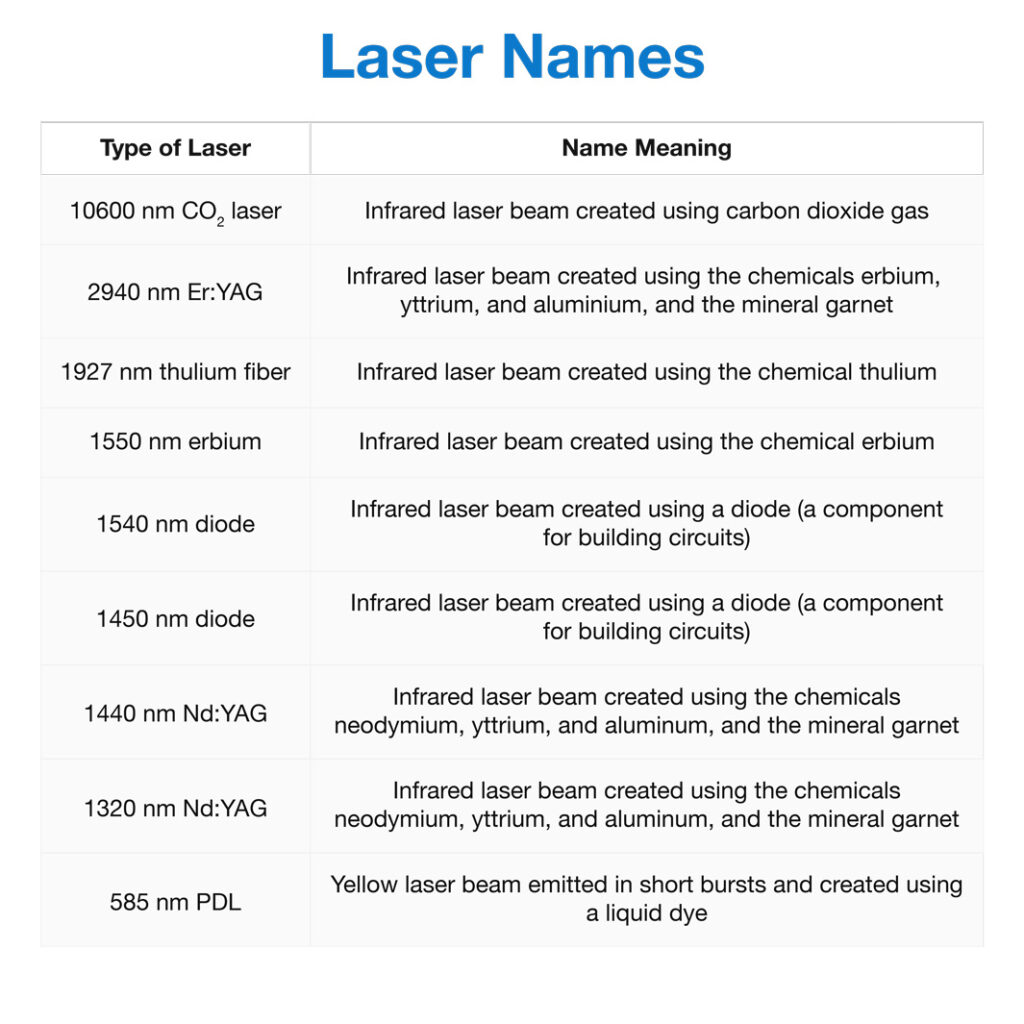
If you would like to learn more about the studies that tested these lasers on dark-skinned (non-Caucasian) patients with acne scars, read on as we dive into the evidence.
The Evidence
Since we are most interested in studies that tested lasers on darker-skinned (non-Caucasian) patients, let’s look at how scientists record patients’ skin color using the so-called Fitzpatrick scale.
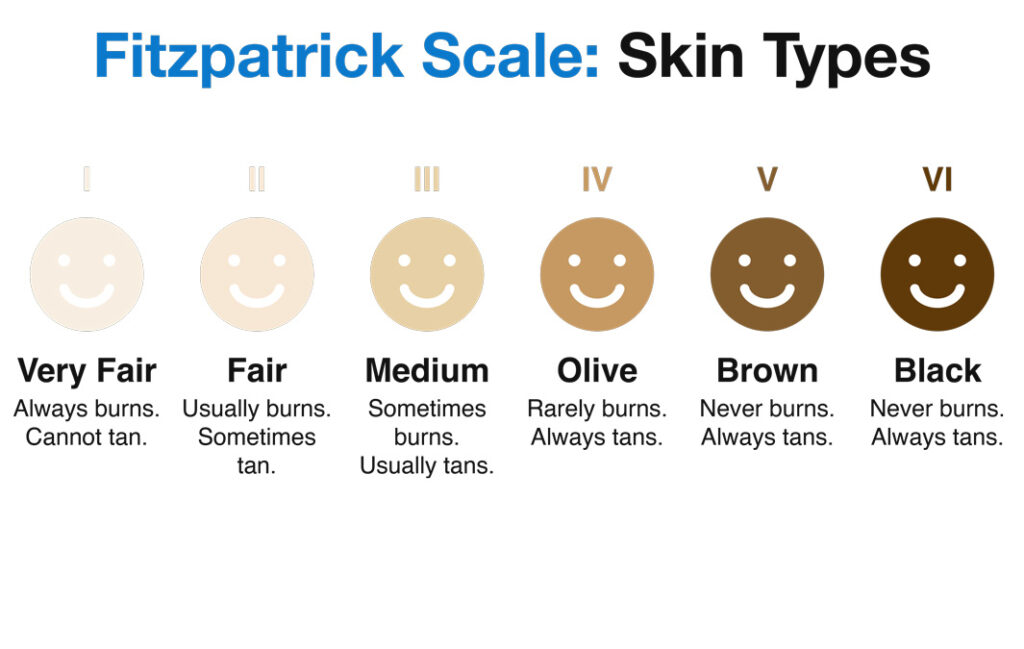
In the Fitzpatrick scale, scientists assign a Roman numeral to a patient’s skin type by comparing his skin color to these images:
When we say that a study tested laser treatment on people with darker (non-Caucasian) skin, we mean people with skin types IV-VI.
Now let’s look at the details of the studies, starting with the best laser for treating acne scars in dark-skinned people.
The #1 Laser: Studies on hyperpigmentation after acne scar repair with the 1550 nm erbium laser
Five studies have tested the 1550 nm erbium laser on a total of 1,078 patients with skin types I-V. Of all these patients, only 17 patients, or less than 2%, developed hyperpigmentation. 1,4,5,7,9
The authors of the largest study, which included 961 participants, analyzed which skin types tended to get hyperpigmentation. They found that for skin type III, the risk was 2.6%, while for type IV, the risk was 11.6%. Finally, for skin type V, the darkest in any of these studies, the risk of hyperpigmentation from treatment with the 1550 nm erbium laser was 33%.10 The authors of one study did note that the hyperpigmentation disappeared within 2 weeks.1
This research suggests while the 1550 nm erbium laser is the second-best laser, the darker your skin, the more your risk of hyperpigmentation from this laser increases.
Expand to reveal more details of studies
The first study was published in 2009 in the Journal of the European Academy of Dermatology and Venereology.1 This study tested the erbium-glass laser. The points below summarize key information about the study.
- Number of patients treated with this laser: 8
- Skin types of patients: IV
- Acne scar severity: Mild-to-severe atrophic scars
- Number of laser treatments: 1
- Frequency of laser treatments: Not applicable
- Acne scar improvement after laser: 26-50% improvement in 6 patients, 51-75% improvement in 1 patient, and minimal to no improvement in 1 patient three months after treatment
- Hyperpigmentation after laser: 1 patient, skin type not specified
The second study was published in 2011 in the journal Lasers in Surgery and Medicine.4 This study tested the fractional erbium-doped fiber laser.
- Number of patients treated with this laser: 45
- Skin types of patients: III-V
- Acne scar severity: Unknown
- Number of laser treatments: 4-6
- Frequency of laser treatments: Once a month
- Acne scar improvement after laser: 35% of patients attained improvement of over 50%
- Hyperpigmentation after laser: 17% of patients, skin types not specified
The third study was published in 2007 in the Journal of Dermatologic Surgery.5 This study also tested the fractional erbium-doped fiber laser.
- Number of patients treated with this laser: 53
- Skin types of patients: I-V
- Acne scar severity: Mild-to-moderate atrophic acne scars
- Number of laser treatments: 1-3
- Frequency of laser treatments: Once every 4 weeks until patients were satisfied with results
- Acne scar improvement after laser: 91% of patients experienced at least 25% improvement in scar appearance after one treatment; 87% of patients experienced at least 51% improvement after 3 treatments
- Hyperpigmentation after laser: 1 patient with skin type V
The fourth study was published in 2008 in the Journal of Dermatologic Surgery.7 This study tested the fractional erbium-doped laser.
- Number of patients treated with this laser: 961
- Skin types of patients: I-V
- Acne scar severity: Unknown
- Number of laser treatments: Unknown
- Frequency of laser treatments: Unknown
- Acne scar improvement after laser: Unknown–study only evaluated side effects, not efficacy
- Hyperpigmentation after laser: 0.73% of patients, mostly skin types III-V
The fifth study was published in 2016 in the Journal of Plastic, Reconstructive & Aesthetic Surgery.9 This study tested the fractional erbium-doped fiber laser.
- Number of patients treated with this laser: 11
- Skin types of patients: IV
- Acne scar severity: Unknown
- Number of laser treatments: 1-5
- Frequency of laser treatments: Once every 3 weeks
- Acne scar improvement after laser: An average improvement of 2.2 on a scale of 0-10 (where 0 means no improvement and 10 means excellent improvement)
- Hyperpigmentation after laser: 10% of patients, skin type IV
The #2 laser: Studies on hyperpigmentation after acne scar repair with the 2940 nm Er:YAG laser
Two studies have looked at how likely darker-skinned (non-Caucasian) patients are to develop hyperpigmentation after acne scar treatment with the 2940 nm Er:YAG laser. In these two studies, a total of 43 patients with skin types IV and V underwent the laser treatment, and 12 patients, or roughly a quarter, developed hyperpigmentation.8,9
We should note that all the patients in these studies had relatively dark skin. In other words, the occurrence of hyperpigmentation might be higher than in some of the other studies because all the patients were in the high-risk group. Still, this research suggests that the 2940 nm Er:YAG laser is quite likely to cause temporary hyperpigmentation in people with relatively dark (non-Caucasian) skin.
Expand to reveal more details of studies
The first study was published in 2013 in the Indian Journal of Dermatology, Venereology, and Leprology.8 This study tested the fractional Er:YAG laser. The points below summarize key information about the study.
- Number of patients treated with this laser: 25
- Skin types of patients: IV-V
- Acne scar severity: Unknown
- Number of laser treatments: 4
- Frequency of laser treatments: Once a month
- Acne scar improvement after laser: 96% of patients experienced at least fair improvement
- Hyperpigmentation after laser: 2% of treatment sessions, skin types IV and V
The second study was published in 2016 in the Journal of Plastic, Reconstructive & Aesthetic Surgery.9 This study tested the non-fractional Er:YAG laser.
- Number of patients treated with this laser: 18
- Skin types of patients: IV
- Acne scar severity: Unknown
- Number of laser treatments: 1-2
- Frequency of laser treatments: Once every 6-12 months
- Acne scar improvement after laser: An average improvement of 5.8 on a scale of 0-10 (where 0 means no improvement and 10 means excellent improvement)
- Hyperpigmentation after laser: 60% of patients, skin type IV
The #3 laser: Studies on hyperpigmentation after acne scar repair with the 10,600 nm CO2 laser
Three studies have tested the 10600 nm CO2 laser on patients with acne scars. Taken together, a total of 52 patients underwent the laser treatment. Although the patients’ skin types ranged between I and IV, most of them had skin type IV. Out of these 52 patients, 17 patients or a third developed hyperpigmentation. All of the patients who got hyperpigmentation had skin type IV.1,6,9
This research suggests that the 10600 nm CO2 laser is quite likely to cause temporary hyperpigmentation, especially in people with skin type IV. The risk may be even higher for darker skin types like V and VI, but none of the studies included such participants.
Expand to reveal more details of studies
The first study was published in 2009 in the Journal of the European Academy of Dermatology and Venereology.1 This study tested the fractional CO2 laser. The points below summarize key information about the study.
- Number of patients treated with this laser: 8
- Skin types of patients: IV
- Acne scar severity: Mild-to-severe atrophic scars
- Number of laser treatments: 1
- Frequency of laser treatments: Not applicable
- Acne scar improvement after laser: 26-50% improvement in 5 patients, 51-75% improvement in 2 patients, and over 76% improvement in 1 patient three months after treatment
- Hyperpigmentation after laser: 1 patient, skin type IV
The second study was published in 2008 in the journal Lasers in Surgery and Medicine.6 This study tested the fractional CO2 laser.
- Number of patients treated with this laser: 15
- Skin types of patients: I-IV
- Acne scar severity: Moderate-to-severe acne scars
- Number of laser treatments: 2-3
- Frequency of laser treatments: Once every 1-2 months
- Acne scar improvement after laser: An average of 66.8% improvement in scar depth
- Hyperpigmentation after laser: 0 patients
The third study was published in 2016 in the Journal of Plastic, Reconstructive & Aesthetic Surgery.9 This study tested both the non-fractional and fractional CO2 lasers.
- Number of patients treated with this laser: 17 with non-fractional laser and 12 with fractional
- Skin types of patients: IV
- Acne scar severity: Unknown
- Number of laser treatments: 1-3 for non-fractional laser, 2-4 for fractional laser
- Frequency of laser treatments: Once every 6-12 months for non-fractional laser, once every 2 months for fractional laser
- Acne scar improvement after laser: An average improvement of 6.0 on a scale of 0-10 (where 0 means no improvement and 10 means excellent improvement) for non-fractional laser; an average improvement of 5.2 for fractional laser
- Hyperpigmentation after laser: 80% of patients for non-fractional laser, 20% of patients for fractional laser, skin type IV
The worst laser: Studies on hyperpigmentation after acne scar repair with the 1450 nm diode laser
One study has tested the 1450 nm diode laser on dark-skinned patients with acne scars. In this study, 30 patients with skin types II-IV underwent the laser treatment. Twenty patients or two-thirds developed hyperpigmentation. The scientists wrote, “It was more with [skin] types III and IV.”3
We should keep in mind that we only have one study on this laser type. Still, so far, the statistics are unfavorable and suggest that this laser is very likely to cause hyperpigmentation in darker-skinned (non-Caucasian) patients.
Expand to reveal more details of study
The study was published in 2005 in the Egyptian Dermatology Online Journal.3 The points below summarize key information about the study.
- Number of patients treated with this laser: 30
- Skin types of patients: II-IV
- Acne scar severity: Unknown
- Number of laser treatments: 4-6
- Frequency of laser treatments: Once every 3 weeks
- Acne scar improvement after laser: No improvement in 23.3% of patients, weak improvement in 13.3%, fair improvement in 10%, good improvement in 33.3%, and very good improvement in 20%
- Hyperpigmentation after laser: 20 patients, mostly skin types III and IV
Unrated laser: Study on hyperpigmentation after acne scar repair with the 585 nm PDL laser
One study has looked at how likely patients are to develop hyperpigmentation after acne scar treatment with the 585 nm PDL laser. In this study, 10 patients with skin types I-IV underwent the laser treatment. None of the patients developed hyperpigmentation.2
We should note that 10 participants is a rather small sample. We also do not know exactly how many of these participants had darker (non-Caucasian) skin. For instance, the fact that nobody got hyperpigmentation might be unimpressive if only one of the participants had dark skin.
Still, for now, this laser has a good track record, with 0 study participants developing hyperpigmentation. Expand the section below if you would like to learn more about the treatment details and efficacy in this study.
Expand to reveal more details of study
The study was published in 2002 in the Journal of Dermatologic Surgery.2 The points below summarize key information about the study.
- Number of patients treated with this laser: 10
- Skin types of patients: I-IV
- Acne scar severity: Unknown
- Number of laser treatments: 1
- Frequency of laser treatments: Not applicable
- Acne scar improvement after laser: Scar depth decreased by 47.8%. Researchers rated average improvement as 2.9 out of a maximum of 4.
Hyperpigmentation after laser: 0 patients
2 Things You Can Do to Lessen Your Chances of Developing Hyperpigmentation from Laser Scar Repair
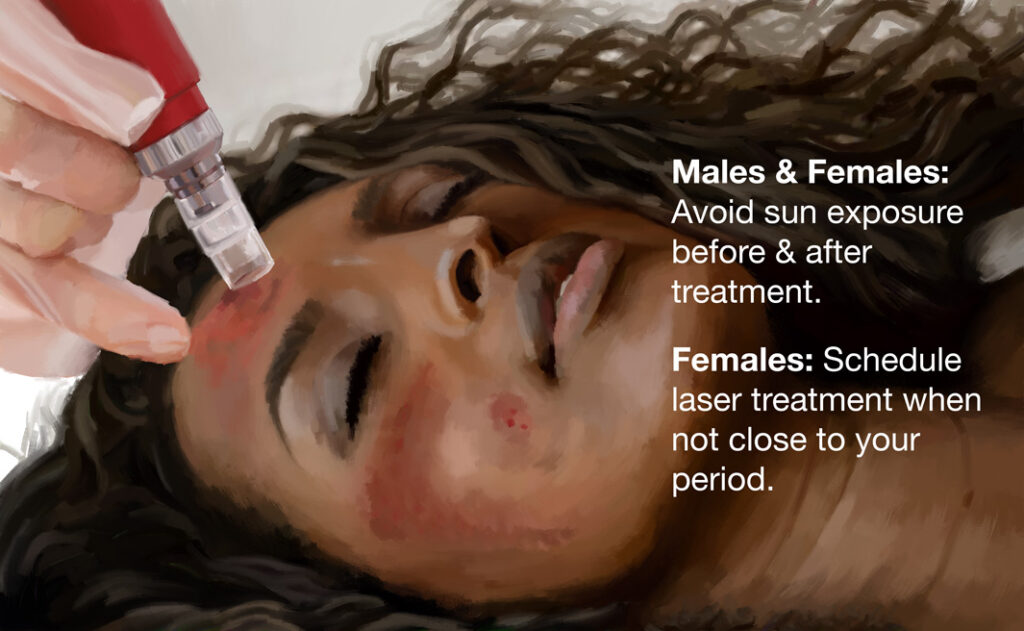
Whichever laser you choose, take these precautions to reduce the likelihood of hyperpigmentation due to laser acne treatment:
- Males and females: Limit sun exposure before and after your laser treatment: Stay out of the sun and apply broad-spectrum sunscreen for at least two weeks before and after laser treatment to reduce your risk of hyperpigmentation and to ensure hyperpigmentation fades faster if it does occur.12
- Females: Avoid scheduling laser appointments close to or during your period: Fluctuating hormone levels around menstruation time stimulate increased production of the skin pigment melanin, which temporarily makes a woman’s skin darker. At this time, she is at higher risk of hyperpigmentation from laser treatment.13-15
In addition, one study indicates that applying a steroid ointment to the skin for two days after laser therapy might help to lower your risk of hyperpigmentation.16 Feel free to ask your dermatologist about this option if you decide to undergo laser scar repair.
The Bottom Line
Dark-skinned (non-Caucasian) patients are at increased risk of developing hyperpigmentation from laser scar repair compared to lighter-skinned people. Research suggests that the 585 nm PDL laser may be the best option for minimizing this risk. The 1450 nm diode laser appears to be the worst, with 66.7% of study participants getting temporary hyperpigmentation.
References
- Cho, S. et al. Non-ablative 1550-nm erbium-glass and ablative 10 600-nm carbon dioxide fractional lasers for acne scars: a randomized split-face study with blinded response evaluation. J. Eur. Acad. Dermatology Venereol. 24, 921–925 (2009).
- Patel, N. & Clement, M. Selective Nonablative Treatment of Acne Scarring With 585 nm Flashlamp Pulsed Dye Laser. Dermatologic Surg. 28, 942–945 (2002).
- Rasheed, A. I. Non-ablative Diode Laser for The Treatment of Post Acne Scars. Egypt. Dermatology Online J. 1, 1–9 (2005).
- Alajlan, A. M. & Alsuwaidan, S. N. Acne scars in ethnic skin treated with both non-ablative fractional 1,550 nm and ablative fractional CO2 lasers: Comparative retrospective analysis with recommended guidelines. Lasers Surg. Med. 43, 787–791 (2011).
- Alster, T., Tanzi, E. & Lazarus, M. The Use of Fractional Laser Photothermolysis for the Treatment of Atrophic Scars. Dermatologic Surg. 33, 295–299 (2007).
- Chapas, A. M. et al. Successful treatment of acneiform scarring with CO2 ablative fractional resurfacing. Lasers Surg. Med. 40, 381–386 (2008).
- Graber, E. M., Tanzi, E. L. & ALSTER, T. S. Side Effects and Complications of Fractional Laser Photothermolysis: Experience with 961 Treatments. Dermatologic Surg. 34, 301–307 (2008).
- Pai, S. et al. Efficacy and safety of Erbium-doped Yttrium Aluminium Garnet fractional resurfacing laser for treatment of facial acne scars. Indian J. Dermatology, Venereol. Leprol. 79, 193 (2013).
- You, H.-J., Kim, D.-W., Yoon, E.-S. & Park, S.-H. Comparison of four different lasers for acne scars: Resurfacing and fractional lasers. J. Plast. Reconstr. Aesthetic Surg. 69, e87–e95 (2016).
- Zuzul, K. The use of lasers in dermatology. (University of Zagreb, 2018). doi:10.2351/1.5057951
- Preissig, J., Hamilton, K. & Markus, R. Current Laser Resurfacing Technologies: A Review that Delves Beneath the Surface. Semin. Plast. Surg. 26, 109–16 (2012).
- Pai, G. S. & Pai, A. H. Q-Switched Laser Treatment for Freckles in Individuals with Skin Type V. Aesthet. Dermatology Surg. 1, 2–7 (2017).
- Al Mohizea, S. The effect of menstrual cycle on laser induced hyperpigmentation. J. drugs dermatology 12, 1335–6 (2013).
- Snell, R. S. & Turner, R. Skin Pigmentation in Relation to the Menstrual Cycle. J. Invest. Dermatol. 47, 147–155 (1966).
- Nanni, C. A. & Alster, T. S. Complications of carbon dioxide laser resurfacing. An evaluation of 500 patients. Dermatologic Surg. 24, 315–20 (1998).
- Cheyasak, N., Manuskiatti, W., Maneeprasopchoke, P. & Wanitphakdeedecha, R. Topical Corticosteroids Minimise the Risk of Postinflammatory Hyperpigmentation After Ablative Fractional CO2 Laser Resurfacing in Asians. Acta Derm. Venereol. 95, 201–205 (2015).
 Acne.org Products
Acne.org Products